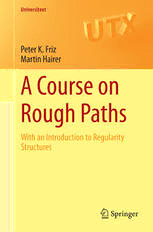Table Of ContentUniversitext
Peter K. Friz
Martin Hairer
A Course on
Rough Paths
With an Introduction to Regularity
Structures
Universitext
Universitext
Series editors
Sheldon Axler
San Francisco State University, San Francisco, CA, USA
Vincenzo Capasso
Università degli Studi di Milano, Milan, Italy
Carles Casacuberta
Universitat de Barcelona, Barcelona, Spain
Angus MacIntyre
Queen Mary University of London, London, UK
Kenneth Ribet
University of California, Berkeley, CA, USA
Claude Sabbah
CNRS, École polytechnique Centre de mathématiques, Palaiseau, France
Endre Süli
University of Oxford, Oxford, UK
Wojbor A. Woyczynski
Case Western Reserve University, Cleveland, OH, USA
Universitext is a series of textbooks that presents material from a wide variety of
mathematical disciplines at master’s level and beyond. The books, often well
class-tested by their author, may have an informal, personal, even experimental
approachtotheirsubjectmatter.Someofthemostsuccessfulandestablishedbooks
intheserieshaveevolvedthroughseveraleditions,alwaysfollowingtheevolution
of teaching curricula, into very polished texts.
Thus as research topics trickle down into graduate-level teaching, first textbooks
written for new, cutting-edge courses may make their way into Universitext.
More information about thisseries athttp://www.springer.com/series/223
Peter K. Friz Martin Hairer
(cid:129)
A Course on Rough Paths
With an Introduction to Regularity Structures
123
Peter K.Friz MartinHairer
Technische UniversitätBerlin Department of Mathematics
Berlin The Universityof Warwick
Germany Coventry
UK
and
Weierstraß-InstitutfürAngewandte
Analysis undStochastik
Berlin
Germany
ISSN 0172-5939 ISSN 2191-6675 (electronic)
ISBN 978-3-319-08331-5 ISBN 978-3-319-08332-2 (eBook)
DOI 10.1007/978-3-319-08332-2
LibraryofCongressControlNumber:2014946769
MathematicsSubjectClassification:60Hxx,34F05,35R60,93E03
SpringerChamHeidelbergNewYorkDordrechtLondon
©SpringerInternationalPublishingSwitzerland2014
Thisworkissubjecttocopyright.AllrightsarereservedbythePublisher,whetherthewholeorpartof
the material is concerned, specifically the rights of translation, reprinting, reuse of illustrations,
recitation,broadcasting,reproductiononmicrofilmsorinanyotherphysicalway,andtransmissionor
informationstorageandretrieval,electronicadaptation,computersoftware,orbysimilarordissimilar
methodology now known or hereafter developed. Exempted from this legal reservation are brief
excerpts in connection with reviews or scholarly analysis or material supplied specifically for the
purposeofbeingenteredandexecutedonacomputersystem,forexclusiveusebythepurchaserofthe
work. Duplication of this publication or parts thereof is permitted only under the provisions of
theCopyright Law of the Publisher’s location, in its current version, and permission for use must
always be obtained from Springer. Permissions for use may be obtained through RightsLink at the
CopyrightClearanceCenter.ViolationsareliabletoprosecutionundertherespectiveCopyrightLaw.
The use of general descriptive names, registered names, trademarks, service marks, etc. in this
publicationdoesnotimply,evenintheabsenceofaspecificstatement,thatsuchnamesareexempt
fromtherelevantprotectivelawsandregulationsandthereforefreeforgeneraluse.
While the advice and information in this book are believed to be true and accurate at the date of
publication,neithertheauthorsnortheeditorsnorthepublishercanacceptanylegalresponsibilityfor
anyerrorsoromissionsthatmaybemade.Thepublishermakesnowarranty,expressorimplied,with
respecttothematerialcontainedherein.
Printedonacid-freepaper
SpringerispartofSpringerScience+BusinessMedia(www.springer.com)
To Waltraud and Rudolf Friz
and
To Xue-Mei
Preface
Sinceitsoriginaldevelopmentinthemid-ninetiesbyTerryLyons,culminatingin
thelandmarkpaper [Lyo98],thetheoryofroughpathshasgrownintoamatureand
widelyapplicablemathematicaltheory,andtherearebynowseveralmonographs
dedicated to the subject, notably Lyons–Qian [LQ02], Lyons et al [LCL07] and
Friz–Victoir[FV10b].Sowhydowebelievethatthereisroomforyetanotherbook
onthismatter?Ourreasonsforwritingthisbookaretwofold.
First,thetheoryofroughpathshasgatheredthereputationofbeingdifficultto
accessfor“mainstream”probabilistsbecauseitreliesonsomenon-trivialalgebraic
and / or geometric machinery. It is true that if one wishes to apply it to signals
of arbitrary roughness, the general theory relies on several objects (in particular
on the Hopf-algebraic properties of the free tensor algebra and the free nilpotent
group embedded in it) that are unfamiliar to most probabilists. However, in our
opinion,someofthemostinterestingapplicationsofthetheoryariseinthecontext
ofstochasticdifferentialequations,wherethedrivingsignalisBrownianmotion.In
thiscase,thetheorysimplifiesdramaticallyandessentiallynonon-trivialalgebraic
orgeometricobjectsarerequiredatall.Thissimplificationiscertainlynotnovel.
Indeed, early notes by Lyons, and then of Davie and Gubinelli, all took place in
thissimplersetting(whichallowstoincorporateBrownianmotionandLe´vy’sarea).
However,itdoesappeartousthatalltheseideascannowadaysbeputtogetherin
unprecedentedsimplicity,andwemadeaconsciouschoicetorestrictourselvesto
thissimplercasethroughoutmostofthisbook.
Thesecondandmainraisond’eˆtreofthisbookisthatthescopeofthetheory
has expanded dramatically over the past few years and that, in this process, the
point of view has slightly shifted from the one exposed in the aforementioned
monographs.WhileLyons’theorywasbuiltontheintegrationof1-forms,Gubinelli
gaveanaturalextensiontotheintegrationofso-called“controlledroughpaths”.Asa
benefit,differentialequationsdrivenbyroughpathscannowbesolvedbyfixedpoint
arguments in linear Banach spaces which contain a sufficiently accurate (second
order)localdescriptionofthesolution.
Thisshiftinperspectivehasfirstenabledtheuseofroughpathstoprovidesolution
theoriesforanumberofclassicallyill-posedstochasticpartialdifferentialequations
vii
viii Preface
with one-dimensional spatial variables, including equations of Burgers type and
theKPZequation.Morerecently,theperspectivewhichemphasiseslinearspaces
containingsufficientlyaccuratelocaldescriptionsmodelledonsome(rough)input,
spurred the development of the theory of “regularity structures” which allows to
giveconsistentinterpretationsforanumberofill-posedequations,alsoinhigher
dimensions.Itcanbeviewedasanextensionofthetheoryofcontrolledroughpaths,
althoughitsformulationissomewhatdifferent.Inthelastchaptersofthisbook,we
giveashortandratherinformal(i.e.veryfewproofs)introductiontothattheory,
whichinparticularalsoshedsnewlightonsomeofthedefinitionsofthetheoryof
roughpaths.
Thisbookdoesnothavetheambitiontoprovideanexhaustivedescriptionofthe
theoryofroughpaths,butrathertocomplementtheexistingliteratureonthesubject.
Asaconsequence,thereareanumberofaspectsthatwechosenottotouch,ortodo
soonlybarely.Oneomissionisthestudyofroughpathsofarbitrarilylowregularity:
wedoprovidehintsatthegeneraltheoryattheendofseveralchapters,buttheseare
self-containedandcanbeskippedwithoutimpactingtheunderstandingoftherest
ofthebook.Anotherseriousomissionconcernsthesystematicstudyofsignatures,
that is the collection of all iterated integrals over a fixed interval associated to a
sufficientlyregularpath,providinganintriguingnonlinearcharacterisation.
Wehaveusedseveralpartsofthisbookforlecturesandmini-courses.Inparticular,
over the last years, the material on rough paths was given repeatedly by the first
authoratTUBerlin(Chapters1-12,intheformofa4h/week,fullsemesterlecturefor
anaudienceofbeginninggraduatestudentsinstochastics)andinsomemini-courses
(Vienna,Columbia,Rennes,Toulouse;e.g.Chapters1-5withaselectionoffurther
topics).ThematerialofChapters13-15originatesinanumberofminicoursesby
the second author (Bonn, ETHZ, Toulouse, Columbia, XVII Brazilian School of
Probability,44thSt.FlourSchoolofProbability,etc).The“KPZandroughpaths”
summerschoolinRennes(2013)wasaparticularlygoodopportunitytotryoutmuch
ofthematerialhereinjointmini-courseform–weareverygratefultotheorganisers
fortheirefforts.Chapters13-15are,arguably,alittlehardertopresentinaclassroom.
Jointly with Paul Gassiat, the first author gave this material as full lecture at TU
Berlin(withexamplesclassesrunbyJoschaDiehl,andmorebackgroundmaterial
on Schwartz distributions, Ho¨lder spaces and wavelet theory than what is found
inthisbook);wealsostartedtouseconsistentlycoloursonourhandouts.Wefelt
the resulting improvement in readability was significant enough to try it out also
inthepresentbookandtaketheopportunitytothankJo¨rgSixtfromSpringerfor
making this possible, aside from his professional assistance concerning all other
aspectsofthisbookproject.Weareverygratefulforallthefeedbackwereceived
fromparticipantsatallthesescourses.Furthermore,wewouldliketothankBruce
Driver,PaulGassiat,MassimillianoGubinelli,TerryLyons,EtiennePardoux,Jeremy
QuastelandHendrikWeberformanyinterestingdiscussionsonhowtopresentthis
material.Inaddition,KhalilChouk,JoschaDiehlandSebastianRiedelkindlyoffered
topartiallyproofreadthefinalmanuscript.
Atlast,wewouldliketoacknowledgefinancialsupport:PKFwassupportedby
theEuropeanResearchCouncilundertheEuropeanUnion’sSeventhFramework
Preface ix
Programme(FP7/2007-2013)/ERCgrantagreementnr.258237andDFG,SPP1324.
MHwassupportedbytheLeverhulmetrustthroughaleadershipawardandbythe
RoyalSocietythroughaWolfsonresearchaward.
BerlinandCoventry, PeterK.Friz
June2014 MartinHairer
Contents
1 Introduction................................................... 1
1.1 Controlleddifferentialequations .............................. 1
1.2 Analogieswithotherbranchesofmathematics .................. 6
1.3 Regularitystructures........................................ 8
1.4 Frequentlyusednotations.................................... 9
1.5 Roughpaththeoryworksininfinitedimensions ................. 11
2 Thespaceofroughpaths........................................ 13
2.1 Basicdefinitions ........................................... 13
2.2 Thespaceofgeometricroughpaths ........................... 16
2.3 RoughpathsasLie-groupvaluedpaths ........................ 17
2.4 Geometricroughpathsoflowregularity ....................... 19
2.5 Exercises ................................................. 20
2.6 Comments ................................................ 25
3 Brownianmotionasaroughpath ................................ 27
3.1 Kolmogorovcriterionforroughpaths.......................... 27
3.2 Itoˆ Brownianmotion........................................ 31
3.3 StratonovichBrownianmotion ............................... 32
3.4 Brownianmotioninamagneticfield .......................... 34
3.5 CubatureonWienerSpace................................... 39
3.6 Scalinglimitsofrandomwalks ............................... 40
3.7 Exercises ................................................. 42
3.8 Comments ................................................ 46
4 Integrationagainstroughpaths.................................. 47
4.1 Introduction ............................................... 47
4.2 Integrationof1-forms....................................... 48
4.3 Integrationofcontrolledroughpaths .......................... 55
4.4 StabilityI:roughintegration ................................. 60
4.5 Controlledroughpathsoflowerregularity...................... 61
xi

